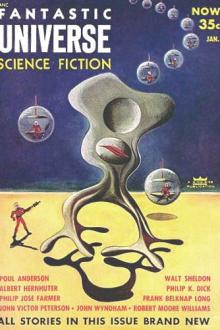The Fourth Child, Jessica Winter [fantasy novels to read txt] 📗

- Author: Jessica Winter
Book online «The Fourth Child, Jessica Winter [fantasy novels to read txt] 📗». Author Jessica Winter
Inside the blank scrubbed room, Jane could see the tall nurse in white. The counterfactual was always present with Mirela. The terror of the counterfactual used to lie in the image of Mirela inher crib, in that place, waiting for a year, and another and another, crying until she accepted that her cries would not beanswered, while her family, an ocean away, puttered around ignoring her, Lauren on a stage or in a swimming pool, the holleringoctopus that was the boys, Pat in the garage, Jane donkeying the groceries up Muegel Road. But now the nurse was beckoningJane out of her own living room. Barbara Walters was blowing a kiss and saying, “Good night, dearest Jane.” The nurse wasswitching off the TV, guiding Jane up the stairs, into the bath, into her bed. She’d been so tired, the night of 20/20. She couldn’t remember if she’d even taken a shower after cleaning up that poor man’s shit.
Jane didn’t always turn away from the nurse. Sometimes she closed her eyes and sank into the almost-scalding bath, the warm towel just out of the dryer—had the nurse taken care of the laundry?—the sheets susurrating against her body as she pressed her face to her pillow, the curtains drawn in the warm dark, the nurse sitting on the edge of the bed, smoothing Jane’s hair, rubbing her back, singing a soft, wordless tune until she fell asleep. The uniform crackling and rustling like white noise, like the wind on the window, so starched it could snap. A branch scraping along the glass, the old leaves crumbling against it. Jane wakes up in a house where Sean still has a bedroom of his own upstairs, where Midnight doesn’t live with the Schecks down the street, where pictures hang on the walls, where there aren’t bars over the windows, where nobody locks the doors.
There was the early childhood development center at UB, a one-way mirror reflecting and penetrating the playroom. Every playroomthat Jane and Mirela visited had its standard chorus of toys: the stacking rings, the shopping cart, the rotary phone in primarycolors, the cheerful croaking puppy-on-a-string. Each toy a standardized test, a multiple-choice bubble that a child filledin by the order in which she stacked the rings or by how lovingly she offered the clacking puppy a strip of plastic steak.
In this playroom, they met Delia, a graduate student whose research focused on emotional regulation. Jane liked Delia immediately.She spoke at low volume and high rapidity, she preferred observations over opinions, and she didn’t interrupt. Her kind andsleepy demeanor, her hooded eyes, reminded Jane of Dr. Vine, how a gauze of exhaustion wrapped his evident quickness and sharpnessin a cottony bundle.
“Have you ever heard of the strange situation?” Delia asked Jane.
“There are so many jokes I could make right now,” Jane said. Mirela babbled like a schoolmarm at her own reflection.
“Ha, I believe it,” Delia said. “It’s an experiment. Dates back to the 1960s and ’70s. What happens is—”
“No, wait, I remember,” Jane said. The small wings of a memory opened and retreated along the top of her head; she squinted slightly as if to glimpse it flapping away toward the Clearfield Library. “I’ve read about this before.”
“So in the strange situation, you put a mother and her child, who’s around one year old, in a room with some toys. The kidcrawls or toddles around, plays with stuff, looks back from time to time to see that Mom is still around, gets onto Mom’slap, gets down, wanders around some more, does his whole baby thing.”
“Yes, yes, I remember this! Then Mom leaves for a while.”
“Exactly. Maybe the baby cries while Mom is gone, maybe he’s okay, maybe he’s anxious. Doesn’t matter all that much, becauseMom comes back. The kid who was anxious or crying is happy to see her again.”
“He finds comfort in her return,” Jane said, nodding.
“Yup, and the kid who was fine when she was gone is also happy she’s back. I’m oversimplifying, but those are basically thetwo outcomes you’d want to see: sad-then-happy, or fine-then-happier. Pretty neat. That’s where you’re seeing what we’d callsecure attachment.”
Mirela laughed and spun herself around in circles until she fell down. She got up again, spun, fell down laughing.
“But in the strange situation, sometimes you don’t see secure attachment,” Delia said.
“Sometimes you get a baby who’s clinging to Mom from the get-go, whining, crying, not wanting to explore the playroom,” Jane said .
“Yup, something like that. Then Mom leaves and the kid explodes. Just totally freaks out. When Mom returns to the room, everythingshould be okay again, right? But sometimes it’s like Mom coming back makes the kid more resentful. She’s darned if she doesand darned if she doesn’t. So that’s another type. We call that anxious-avoidant.”
Mirela spun and fell down and stayed where she was, on her back in a snow angel. She watched the ceiling, engrossed by a shadow-puppet show that only she could see. She softly sang along to the song she could hear them playing up there.
“There’s a third type,” Delia said. “This third type of kid doesn’t explore the room and doesn’t seem to care what Mom isup to. Mom is there, she leaves, she comes back—whatever. This type is what we call anxious-ambivalent, and in some ways,that’s the worst-case scenario. When a baby just doesn’t care.”
“Is it possible to overanalyze it? It could be just that the baby is relaxed. Or having an off day.”
Some children are never allowed even in earliest infancy just to lie back and float. They lose a great deal and may altogether





Comments (0)